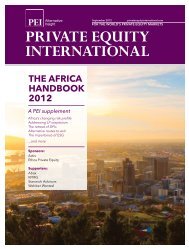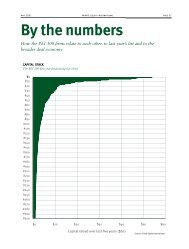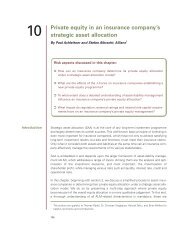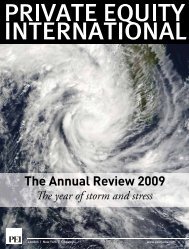The Private Equity Secondaries Market - PEI Media
The Private Equity Secondaries Market - PEI Media
The Private Equity Secondaries Market - PEI Media
You also want an ePaper? Increase the reach of your titles
YUMPU automatically turns print PDFs into web optimized ePapers that Google loves.
<strong>The</strong> <strong>Private</strong> <strong>Equity</strong> <strong>Secondaries</strong> <strong>Market</strong><br />
Edited by Campbell Lutyens<br />
Be prepared for your next big step<br />
Exclusive package of a<br />
200-page book and<br />
100-page directory<br />
www.peimedia.com/secondaries<br />
A PRIVATE EQUITY INTERNATIONAL PUBLICATION<br />
www.peimedia.com
Expert<br />
intelligence<br />
on private<br />
equity<br />
secondaries<br />
<strong>PEI</strong> is delighted to announce the<br />
launch of a new package incorporating<br />
our best-selling book <strong>The</strong> <strong>Private</strong><br />
<strong>Equity</strong> <strong>Secondaries</strong> <strong>Market</strong>, and a<br />
comprehensive new directory WHO’S<br />
WHO in private equity secondaries.<br />
Whether you’re an experienced player<br />
in private equity secondaries or an eager<br />
new entrant, this exciting two-volume<br />
package will be an invaluable resource.<br />
More than 30 leading professionals<br />
reveal exactly how to succeed in<br />
secondaries, what makes a great deal<br />
and precisely what to avoid at all costs.<br />
<strong>The</strong> directory tells you Who’s Who<br />
right now – it’s full of hundreds and<br />
hundreds of contacts at firms in every<br />
market that matters to private equity’s<br />
latest hot ticket.<br />
<strong>The</strong> package also features:<br />
u Current and emerging trends in the<br />
secondaries arena<br />
u Solutions to common risk issues<br />
in the secondaries market<br />
u <strong>The</strong> investment strategies of the<br />
key secondaries players<br />
u Incisive case studies on<br />
secondaries deals<br />
u <strong>The</strong> scope for innovation and<br />
new developments in the market<br />
Why is a secondaries<br />
package relevant now?<br />
It’s all about timing. And being part of<br />
the private equity secondaries market<br />
is one of the surest strategies that will<br />
encourage a flow of much-needed exits,<br />
helping to revitalise the primary market.<br />
<strong>The</strong> secondary market has come of age –<br />
and this year and next are expected to be<br />
historically significant for this important<br />
investment stage. It’s time to be informed<br />
and prepared.<br />
What information will this<br />
package give me that other<br />
titles don’t?<br />
<strong>PEI</strong> understands the needs of the<br />
market. While other publications<br />
raise more questions than offering<br />
solutions with their random data<br />
offerings and puzzles, <strong>PEI</strong>’s secondaries<br />
tool kit is designed to sharpen your<br />
game. <strong>The</strong> strong practical nature<br />
of this package makes every bit<br />
of information relevant to your<br />
understanding of the market. It lets<br />
you know who is doing what where,<br />
and how to take advantage of the<br />
increasing opportunities.<br />
A PRIVATE EQUITY INTERNATIONAL PUBLICATION
Contents<br />
Part I Introduction and contemporary<br />
analysis of the secondary market<br />
Chapter 1 Introduction<br />
Andrew Sealey, Campbell Lutyens<br />
Recent developments<br />
Chapter summary<br />
Chapter 2 Different types of secondaries<br />
E. Livingstone and I. Richards, Pantheon Ventures<br />
Portfolio secondaries<br />
<strong>The</strong> emergence of ‘early secondaries’<br />
Secondary directs – ‘spin-outs’<br />
Secondary directs – ‘buy-ins’<br />
Stapled transactions<br />
Structuring<br />
Cash and paper deals<br />
Retaining upside potential<br />
Vendor financing<br />
Leverage and securitisation<br />
Transfer of economic interest<br />
<strong>The</strong> minimum requirements for a secondary<br />
transaction<br />
Secondary transactions versus direct investing<br />
<strong>The</strong> future of the secondary market<br />
Part II Liquidity in the market for portfolio<br />
fund transactions<br />
Chapter 3 Key issues in portfolio<br />
fund transactions<br />
Michael Granoff, Mark Maruszewski and<br />
Tom Bradley, Pomona Capital<br />
Competitiveness<br />
Maturity of portfolio<br />
GP involvement<br />
GP consent<br />
Transfer restrictions<br />
Asset mix<br />
Leverage<br />
Information access<br />
Secondary fund lifecycle<br />
Chapter 4 Trends towards active<br />
portfolio management in private equity<br />
Oliver Gardey and Jason Gull, Adams Street Partners<br />
Introduction<br />
A case study of portfolio management<br />
Larger private equity allocations drive increases<br />
in active portfolio management<br />
Facilitating active portfolio management<br />
Key considerations in a secondary portfolio sale<br />
Chapter 5 Alternative routes to liquidity:<br />
securitising private equity<br />
Filip Henzler, Capital Dynamics<br />
Introduction<br />
Rationale of securitising private equity<br />
<strong>The</strong> process of securitising private equity<br />
<strong>Market</strong> outlook<br />
Part III the market for secondary direct<br />
transactions<br />
Chapter 6 <strong>The</strong> linkage between the<br />
primary and secondary markets<br />
Wouter Moerel, AlpInvest Partners<br />
Introduction<br />
<strong>Market</strong> overview<br />
Conflicting interests and objectives<br />
Creating the win-win<br />
Case study: Lyceum Capital<br />
Chapter 7 <strong>The</strong> rise and rise of the<br />
secondary direct<br />
David Williamson, Nova Capital Management<br />
Introduction<br />
Defining our space<br />
Fitting into the broader market<br />
What are secondary directs?<br />
Sellers and buyers<br />
What do the transactions involve?<br />
Key issues<br />
<strong>The</strong> future<br />
Chapter 8 Investment considerations<br />
in direct secondary transactions<br />
David Atterbury, HarbourVest Partners (UK) Limited<br />
Evolution of the secondary market: new sources<br />
of deal flow to manage<br />
<strong>The</strong> GP: relationships matter<br />
Appropriate due diligence: a balancing act<br />
Financing: creative approaches to maximise returns<br />
Structure and terms: a custom fit<br />
Post-completion: relationships remain key<br />
Chapter 9 Legal and tax considerations<br />
to secondary and other sales<br />
Mark Mifsud, Kirkland & Ellis International LLP<br />
and David Schwartz, Debevoise & Plimpton LLP<br />
Introduction<br />
<strong>Secondaries</strong> involving existing limited partnerships<br />
<strong>Secondaries</strong> involving direct private equity<br />
investments<br />
Part IV Innovations and new developments<br />
in secondary transactions<br />
Chapter 10 <strong>Private</strong> equity – fund leverage<br />
Ian Shanks, Bank of Scotland<br />
Background<br />
When is unrated ‘senior debt’ being used and why?<br />
How is senior debt typically deployed?<br />
Senior debt leverage characteristics<br />
Return benefit<br />
<strong>The</strong> future<br />
Chapter 11 <strong>The</strong> use of insurance capital<br />
solutions in the secondary market<br />
Daniel Max, Marsh<br />
Introduction
<strong>The</strong> relationship between risk and reward<br />
Portfolio fund transfers<br />
Insurance based solutions<br />
<strong>The</strong> insurance of unknown liabilities<br />
<strong>The</strong> insurance of known liabilities<br />
Chapter 12 Structured private<br />
equity vehicles and their demand<br />
for secondaries<br />
Sam Robinson, SVG Advisers<br />
Quote unquote<br />
Too much cash is a drag<br />
Structured for enhanced returns<br />
Chapter 13 <strong>The</strong> role of the financial<br />
adviser in secondary transactions<br />
Immanuel Rubin, Campbell Lutyens<br />
Sale of a portfolio of fund interests:<br />
adviser acting for the vendor<br />
Advising on stapled transactions<br />
Chapter 14 Opportunities<br />
in emerging markets<br />
Pablo Calo, Valerie Chen and Kennon Koay,<br />
AIG Investments<br />
Overview of private equity in emerging markets<br />
Size of the secondary market<br />
Supply side of secondary deal flow<br />
Pricing of secondary transactions<br />
Implications on exit risk<br />
Conclusions<br />
Chapter 15 Property fund secondaries<br />
Gary P. Stevens and James J. Sunday,<br />
Landmark Partners<br />
Evolution of the real estate secondary market<br />
Real estate secondary market dynamics<br />
Differences between real estate and<br />
private equity secondary markets<br />
Outlook<br />
Conclusions for the real estate<br />
secondary market<br />
PART V Conclusion<br />
Chapter 16 Conclusion<br />
Andrew Sealey, Campbell Lutyens<br />
Outlook for the secondaries market<br />
and future trends<br />
APPENDIX I – Survey<br />
Commentary by Ben Pearce,<br />
Campbell Lutyens<br />
<strong>The</strong> private equity secondaries market survey<br />
Introduction<br />
Sell-side survey results<br />
Buy-side survey results<br />
Conclusions<br />
APPENDIX II – Case studies<br />
Case study 1: <strong>Secondaries</strong> –<br />
a tool for increasing efficiency<br />
in fund of funds management<br />
Francesco di Valmarana, Unigestion<br />
Case study 2: Opting for a hybrid<br />
direct–indirect secondary structure<br />
in Vivendi/Tempo deal<br />
Philippe Charquet, Tempo Capital Partners<br />
Case study 3: Paul Capital’s Project<br />
Ritz: bringing in a ‘for hire’ manager<br />
Elaine L. Small, Paul Capital Partners<br />
Case study 4: Creating a win-win<br />
solution for an orphaned portfolio<br />
Sebastian Junoy and Laura Shen,<br />
Headway Capital Partners<br />
Case study 5: Selling a portfolio of<br />
fund interests and of minority direct<br />
investments – Infineon Technologies<br />
André Aubert and Sascha Gruber,<br />
LGT Capital Partners<br />
Case study 6: How to sell ‘non-core’<br />
divisions fast – the Northern Foods<br />
way<br />
Thierry de Panafieu, Vision Capital<br />
Case study 7: Unlocking the portfolio<br />
of French Government development<br />
agency Oséo<br />
Benjamin Bréard, Dahlia Partners<br />
Case study 8: Siemens –<br />
active portfolio management<br />
by a global corporate investor<br />
Tom S. Anthofer, Cipio Partners<br />
Case study 9: Astrea – securitisation<br />
as a path to secondary liquidity<br />
Filip Henzler, Capital Dynamics and<br />
Manuel Etter<br />
APPENDIX III THE DIRECTORY<br />
Managers of secondary funds<br />
APPENDIX IV IN THE NEWS<br />
News stories from <strong>PEI</strong> <strong>Media</strong>’s online<br />
news service, <strong>Private</strong> <strong>Equity</strong> Online<br />
(www.privateequityonline.com)<br />
www.peimedia.com/secondaries<br />
“<strong>The</strong> secondary<br />
market can<br />
be used by<br />
investors to do<br />
rebalancing,<br />
thereby<br />
improving<br />
overall portfolio<br />
returns and risk<br />
characteristics.”<br />
Andrew Sealey, Campbell Lutyens
Sample content<br />
Extract from:<br />
Trends towards active portfolio management in private equity<br />
By Oliver Gardey and Jason Gull,<br />
Adams Street Partners<br />
Attitudinal changes in the GP<br />
and LP relationship<br />
In the past, certain institutional<br />
investors perceived that a stigma was<br />
attached to a secondary sale, which<br />
caused some to think twice about a sale.<br />
It was further believed by some that<br />
institutional investors who sold their<br />
limited partnership interests would be<br />
accused of being either an unreliable<br />
LP or an institution in distress. Many<br />
prospective sellers are particularly<br />
sensitive to protecting their reputations<br />
because they would like to ensure that a<br />
secondary sale will not limit their future<br />
access to top quartile funds.<br />
However, with the growth of the<br />
secondary market touching all GPs<br />
at one point in time or another, and the<br />
existence of sophisticated institutional<br />
investors with large allocations to private<br />
equity, the GPs have become more<br />
familiar with the practice of actively<br />
managing a private equity portfolio.<br />
In fact, GPs often work closely with their<br />
selling LPs and interested buyers as<br />
an opportunity to control, refresh and<br />
improve their LP base. A secondary sale<br />
allows the GP to replace a short-term<br />
investor base with a more long-term<br />
committed investor base. <strong>The</strong> enormous<br />
growth of the LP investor base has given<br />
the GP much more comfort that their<br />
LPs are replaceable, and that they need<br />
to think strategically about managing<br />
their own ‘portfolio’ of LPs.<br />
<strong>The</strong> emergence of specialised<br />
secondary intermediaries<br />
In the past, the only option an institutional<br />
investor had to manage a secondary<br />
sale process was to do it themselves.<br />
With many institutional investors<br />
short-staffed, the prospect of managing<br />
a sales process can be daunting.<br />
Many institutions with private equity<br />
allocations do not have the resources<br />
or the expertise to engage themselves<br />
in a sales process. <strong>The</strong> GPs need to<br />
be contacted; information collected,<br />
organised and put in distributable<br />
form; a short-list of prospective buyers<br />
identified and contacted; and most<br />
importantly, understanding is needed<br />
of what price to sell the portfolio for.<br />
<strong>The</strong>refore, many private equity portfolio<br />
managers contemplate a sale but don’t<br />
engage in one.<br />
However in the past five years, several<br />
firms have identified the opportunity<br />
to offer their services to institutions<br />
with large private equity portfolios and<br />
assist in the sales process. Although<br />
still accounting for a minority of all<br />
transactions, intermediaries have provided<br />
critical services to certain institutions<br />
unable to run their own sales process.<br />
Coller Capital<br />
HarbourVest Partners<br />
RREEF Alternative Investments<br />
Head office<br />
Branch offices<br />
Geographic coverage<br />
Head office<br />
Branch offices<br />
Geographic coverage<br />
Head office<br />
Branch offices<br />
Geographic coverage<br />
33 Cavendish Square<br />
New York, United States of America Global<br />
London<br />
Singapore, Singapore<br />
North America<br />
W1G 0TT<br />
Western Europe<br />
United Kingdom<br />
Central & Eastern Europe<br />
Asia Pacific<br />
Tel: +44 20 7631 8500<br />
Latin America<br />
Middle East<br />
Fax: +44 20 7631 8555<br />
Africa<br />
Web: www.collercapital.com<br />
Fund type<br />
Email: see Key contacts<br />
Generalist<br />
Buyout<br />
Year established<br />
Mid-market<br />
1990<br />
Venture<br />
Mezzanine<br />
Assests/funds under management<br />
Turnaround/Distressed<br />
$8 billion (as of 31 Dec 2008)<br />
Other<br />
One Financial Center, 44th Floor London, United Kingdom<br />
Boston, MA 02111<br />
Hong Kong, China<br />
United States of America<br />
Tel: +1 617 348 3707<br />
Fax: +1 617 350 0305<br />
Web: www.harbourvest.com<br />
Email: usinfo@harbourvest.com<br />
Year established<br />
1982<br />
Assests/funds under management<br />
$18 billion<br />
Global<br />
North America<br />
Western Europe<br />
Central & Eastern Europe<br />
Asia Pacific<br />
Latin America<br />
Middle East<br />
Africa<br />
Fund type<br />
Buyout<br />
Mid-market<br />
Venture<br />
Mezzanine<br />
Turnaround/Distressed<br />
Other<br />
60 Wall Street<br />
London, United Kingdom<br />
New York, NY 10005<br />
United States of America<br />
Tel: +1 212 250 7171<br />
Fax: +1 212 797 0279<br />
Web: www.rreef.com<br />
Email: see Key contacts<br />
Year established<br />
1996<br />
Assests/funds under management<br />
€53.3 billion (as of 31 Dec 2008)<br />
Global<br />
North America<br />
Western Europe<br />
Central & Eastern Europe<br />
Asia Pacific<br />
Middle East<br />
Fund type<br />
Generalist<br />
Buyout<br />
Mid-market<br />
Venture<br />
Mezzanine<br />
Turnaround/Distressed<br />
Key contacts<br />
Jeremy Coller<br />
Frank Morgan<br />
Joseph Marks<br />
Chief Investment Officer, London Partner, New York<br />
Principal, New York<br />
Jeremycoller@collercapital.com Frank.morgan@collercapital.com Joseph.marks@collercapital.com<br />
Daniel Dupont<br />
Hiro Mizuno<br />
Sebastien Burdel<br />
Partner, London<br />
Partner, London<br />
Principal, New York<br />
Daniel.dupont@collercapital.com Hiro.mizuno@collercapital.com Sebastien.burdel@collercapital.com<br />
Erwin Roex<br />
Timothy Jones<br />
Alex Sao-Wei Lee<br />
Partner, London<br />
Partner, London<br />
Principal, Singapore<br />
Erwin.roex@collercapital.com Jones@collercapital.com<br />
Alex.lee@collercapital.com<br />
Jonathan Gutstein<br />
Alex Hansing<br />
Pinal Nicum<br />
Partner, London<br />
Partner, London<br />
Principal, London<br />
Jonathan.gutstein@collercapital.com Alex.hansing@collercapital.com Pinal.nicum@collercapital.com<br />
Jonathon Freeman<br />
Crispin Payne<br />
Stephen Ziff<br />
Partner, London<br />
Partner, London<br />
Principal, London<br />
Jonathon.freeman@collercapital.com Crispin.payne@collercapital.com Stephen.ziff@collercapital.com<br />
Luca Salvato<br />
Peter Holden<br />
Andrew Caspersen<br />
Principal, New York<br />
Partner, New York<br />
Principal, New York<br />
Luca.salvato@collercapital.com Peter.holden@collercapital.com Andrew.caspersen@collercapital.com<br />
Background<br />
Coller Capital was formed in 1990 and is the leading global investor in private equity secondaries – the<br />
purchase of original investors stakes in private equity funds (venture capital, buyout, and mezzanine) or the<br />
acquisition of portfolios of companies from corporate owners/backers.<br />
In April 2007, Coller Capital closed its fifth fund with commitments of $4.8 billion from 200 international<br />
institutional investors.<br />
Key contacts<br />
Secondary investment team: David Atterbury<br />
Abraham Soquar<br />
John M. Begg<br />
Principal, London<br />
Senior Associate, Hong Kong<br />
Managing Director, Boston<br />
datterbury@harbourvest.com asoquar@harbourvest.com<br />
jbegg@harbourvest.com<br />
Tel: +44 20 7399 9836<br />
Tel: +852 2878 5621<br />
Tel: +1 617 348 3742<br />
Jeffrey R. Keay<br />
Gregory P. Ciesielski<br />
Brett A. Gordon<br />
Principal, Boston<br />
Associate, London<br />
Managing Director, Boston<br />
jkeay@harbourvest.com<br />
gciesielski@harbourvest.com<br />
bgordon@harbourvest.com Tel: +1 617 348 3536<br />
Tel: +44 20 7399 9812<br />
Tel: +1 617 348 3764<br />
John M. Fiato<br />
Barbara E. Duesberg<br />
Frederick C. Maynard<br />
Vice President, Boston<br />
Associate, London<br />
Managing Director, Boston<br />
jfiato@harbourvest.com<br />
bduesberg@harbourvest.com<br />
fmaynard@harbourvest.com Tel: +1 617 348 3540<br />
Tel: +44 20 7399 9837<br />
Tel: +1 617 348 3723<br />
Valerie Handal<br />
Alexander Frick<br />
John M. Toomey, Jr<br />
Vice President, London<br />
Associate, London<br />
Managing Director, Boston<br />
vhandal@harbourvest.com<br />
africk@harbourvest.com<br />
jtoomey@harbourvest.com Tel: +44 20 7399 9816<br />
Tel: +44 20 7399 9838<br />
Tel: +1 716 348 3525<br />
Michael J. Pugatch<br />
Matthew Souza<br />
Peter G. Wilson<br />
Vice President, Boston<br />
Senior Secondary Portfolio<br />
Managing Director, London mpugatch@harbourvest.com Associate, Boston<br />
pwilson@harbourvest.com<br />
Tel: +1 617 348 3712<br />
msouza@harbourvest.com<br />
Tel: +44 20 7399 9824<br />
Tel: +1 617 348 3723<br />
Rajesh Senapati<br />
Senior Associate, Boston<br />
rsenapati@harbourvest.com<br />
Tel: +1 617 348 3647<br />
Background<br />
HarbourVest Partners is a global private equity fund of funds manager. It was founded in 1997 to assume the<br />
business of Hancock Venture Partners, Inc, which was formed in 1982. <strong>The</strong> firm’s clients include more than<br />
240 pension funds, endowments, foundations, and financial institutions from the US, Europe, Canada,<br />
Key contacts<br />
Charles B. Leitner III<br />
Charles Smith<br />
Marc Nahum<br />
Global Head of RREEF Alternative Managing Director, Head of RREEF Director, RREEF <strong>Private</strong> <strong>Equity</strong>,<br />
Investments<br />
<strong>Private</strong> <strong>Equity</strong>, London<br />
London<br />
chuck.leitner@rreef.com<br />
charles.f.smith@rreef.com<br />
marc.nahum@rreef.com<br />
Tel: +44 20 7547 6781<br />
Tel: +44 20 7547 2494<br />
Timothy B. Keith<br />
Chief Executive Officer, RREEF Carlo Pirzio-Biroli<br />
Adam Graev<br />
Infrastructure and <strong>Private</strong> <strong>Equity</strong> Managing Director, Head of Global Director, RREEF <strong>Private</strong> <strong>Equity</strong>,<br />
Secondary Investing, RREEF <strong>Private</strong> New York<br />
Chris Hughes<br />
<strong>Equity</strong>, London<br />
adam.graev@rreef.com<br />
Head of Global <strong>Private</strong> <strong>Equity</strong> and carlo.pirzio-biroli@rreef.com Tel: +1 212 454 1047<br />
Hedge Funds, New York<br />
Tel: +44 20 7545 9476<br />
chris.hughes@@rreef.com<br />
Background<br />
RREEF Alternative Investments is the global alternative investment management business of Deutsche<br />
Bank’s Asset Management division. RREEF Alternative Investments consists of four businesses: real estate,<br />
infrastructure, private equity and hedge funds. RREEF had €53.3 billion in assets under management<br />
worldwide as of 31 December 2008.<br />
Secondary private equity transactions and minority co-investments are pursued through the DB Secondary<br />
Opportunities Funds. In 2007, RREEF closed DB Secondary Opportunities <strong>Private</strong> <strong>Equity</strong> Fund at $775 million.<br />
<strong>The</strong> fund will purchase secondary positions in existing partnerships and portfolios of direct investments. In<br />
addition, the fund will also co-invest in companies alongside other private equity investors. Institution types that<br />
have invested in their funds include pension plans, fund of funds and family offices.<br />
Secondary funds managed by the group include:<br />
Fund name Size Year Region<br />
DB Secondary Opportunities<br />
$775m 2007 Global<br />
<strong>Private</strong> <strong>Equity</strong> Fund<br />
Seconday Funds 17<br />
Seconday Funds 29<br />
Seconday Funds 63<br />
<strong>The</strong> above pages are sample entries from Who’s Who in private equity secondaries. <strong>The</strong> directory, which was researched<br />
in March and April 2009, presents a trusted listing of everyone who is active in the private equity secondaries market.

















